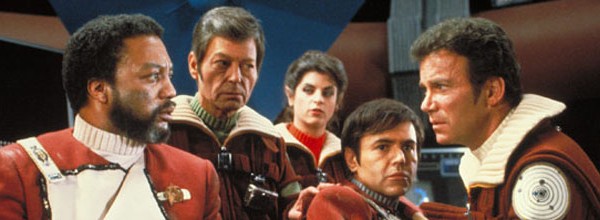Ahead of the release of Star Trek Into Darkness in cinemas on Thursday 9 May, each week we’re rewatching a classic Star Trek movie, continuing this week with 1982’s Star Trek II: The Wrath of Khan…
> Buy the complete Star Trek movies boxset on Amazon.
The story
Whilst hunting for a dead planet, Chekov bumps into old villain Khan, who immediately takes control of the situation (and Chekov too) in order to pursue Admiral James T Kirk and settle old scores.
Matters are complicated when Khan manages to get hold of the Genesis Project, a device that is capable of creating life, overseen by Kirk’s old lover, who has created a significant life all of her own. Meanwhile, Kirk rediscovers his youth, and Spock applies logic to its most – well, logical – conclusion.
Best moments
The first sequence (trading on a leaked rumour that Nimoy’s Spock would be killed off in this movie) lays down the action credentials that separate this from the first movie, has a great, iconic reveal for William Shatner, introduces the Kobayashi Maru to the Star Trek mythos, and manages to wrong foot the audience at almost every turn.
Ricardo Montalban’s urbane performance sets a template for pretty much any cultured, book-quoting villain that will follow, from Die Hard down. His introduction of his little pets – the Ceti Eels – manages to be both charming and chilling.
Saavik (Kirstie Alley) is a great addition to the cast, giving the regulars something new to play off (‘she changed her hair?’/’I hadn’t noticed’), as well as being a decent character in her own right, as opposed to simply serving as a plot device (something that gets fumbled with Kim Cattrall ‘s character in The Undiscovered Country).
Kirk is told that he has never faced death, which he acknowledges impishly. Later in the film, one of the franchise’s highlights occurs when he is literally made to face death while listening to the words ‘Live Long And Prosper…’
Trivia
» All of Khan’s men were actually Chippendale dancers.
» We hear the iconic ‘Space, the final frontier’ speech for the first time since the TV series, slightly altered, and now spoken by Leonard Nimoy.
» Khan and Kirk never meet face to face in the movie.
» According to director Nicolas Meyer, the impressive chest that Ricardo Moutbouatn displays is actually his, hard earned after a regime of press -ups (‘a lot of press ups’), and not, as has been assumed, a fake prosthetic.
» This is the first appearance of the now iconic Kobayashi Maru test, subsequently to be referenced in many media, including the 2009 prequel Star Trek.
Best quotes
» Khan: ‘He tasks me. He tasks me and I shall have him! I’ll chase him ’round the moons of Nibia and ’round the Antares Maelstrom and ’round Perdition’s flames before I give him up!’
» Kirk: ‘As a doctor, you of all people should be aware of the dangers of reopening old wounds.’
» Spock: ‘The needs of the many outweigh the needs of the few.’
» Kirk: ‘Of my friend, I can only say this: of all the souls I have encountered in my travels, his was the most [voice breaks]… human.’
» And, altogether now… Kirk, grim-faced, sweaty, clenching a fist: ‘KKHHHHAAAAAN!’
The verdict
There’s no point in even attempting to claim anything different: this is the best Star Trek movie by some light-years. Yes, we know it’s the obvious, standard claim, but it happens to be undeniably true. More than that, it’s not just a great Star Trek movie, it also happens to be a very good, tightly constructed sci-fi actioner, full stop.
There’s not an ounce of wasted screentime. Much of this is a result of the characters being served excellently by the plot: Spock’s logical attitude drives the narrative often (‘I have no ego to bruise’), and indeed provides a way in to the final scenes. McCoy’s light sardonic touch perfectly balances his moments of outraged righteousness (in many ways, serving the same narrative role as Ian Malcolm in Jurassic Park). Even Chekov’s habit of being side-lined to victim role has a purpose here, and Scotty’s Celtic roots (and family connections) are exploited well. Having said all that, it’s true that both Sulu and Uhura suffer in weakly written cameos.
This is the film where the franchise becomes what we recognise as Star Trek today. A major element, continued in most of the films that follow, is the recognition that these characters from the future have a history, a past: one that they share with us. And so we now have characters, Federation and Klingon alike, grappling with ancient books and quoting Shakespeare and Dickens.
While it wasn’t universally popular (certainly not with Star Trek creator Gene Rodenberry), it also helps that the Enterprise and its crew are given a much more nautical, seafaring feel. This is referenced in the whistles that greet characters as they board the ship, but largely in the plot itself, borrowing as it does from Herman Melville.
Here, we like Star Trek: The Motion Picture more than the average Trekkie, but it can’t be denied that the franchise was in urgent need of new blood. It seems vastly appropriate that a movie that’s all about creating new life was the one to jump-start the series.
> Buy the complete Star Trek movies boxset on Amazon.
What do you think of the movie? Let us know below…

